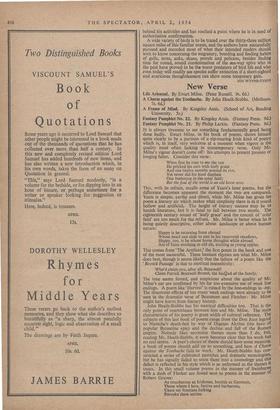Bird Books
The Birds of the British Isles. By D. A. Bannerman. Illustrated by George E. Lodge. Volume One: Corvidae, Sturnidae, Oriolidae, Fringillidae. (Oliver and Boyd. 45s.) sea-Birds. By James Fisher and R. M. Lockley. (Collins. 25s.) THE study of birds is increasingly the province of the scientist. The days of the amateur ornithologist who was content to regard avian behaviour with more or less the same tolerant imprecision With which he observed the habits of his fellow men, are practically over. Today's naturalist is more at ease with his microscope than with his field-glasses. The excreta of the little owl titillates 'us imagination to a far greater degree than the more abstract Pleasures discovered by his predecessors in the observation of birds and animals under natural conditions. Success is judged less by the 81:0wth of humanity and wisdom in the observer than by the com- pleteness and complexity of his files and note-books. It is to be feared that a large proportion of ornithologists will therefore regard the first volume of Dr. Bannerman's projected survey of British birds (promised in six volumes, the first three of Which are to deal entirely with the passerine species) as indicative of nu smaller, sin than prolixity and of none greater than the cardinal crime of indifference to some few thousands of the biological details 80 eagerly tabulated by the modern school. The same critics may 111,80 be pained by the paintings of George Lodge. They will not Ke to see his birds perching on things like hedges and conifers When they could more economically be suspended in vacuity, and criticism may well be levelled at a technique that depicts a bird In the colours and stance observed by the human eye under natural conditions instead of crucifying the subject hygienically on a crowded !beet of shiny white art paper in hues designed to accentuate tell-tale features and facilitate distinctions only truly learnt by long and Patient man-to-bird association. But this is not to denigrate the value and •good intentions of Such field guides as Collins's Pocket Guide to British Birds and their 'few Field Guide to the Birds. of Britain and Europe. True, one would not be surprised if the urge to make up a trilogy sooner or later lesulted in a 300-page field guide to the birds of our planet in all languages, but despite the deficiencies inevitable in a side-pocket- Tzed volume which aims at providing recognition pictures, distinctive the marks, and the French, German, Swedish and Dutch names of all !nit birds of Europe, in addition to most of the details generally expected from field reference books, this is as competent and detailed work as one could reasonably expect for size and price. But it cannot be over-emphasised that there is no escaping diligent first- hand field-work, or at least the earnest study of comprehensive monographs, if more than the most tentative knowledge of this vast subject is desired. Realistically sub-titled 'An Introduction to the Natural History ?f the Sea-Birds of the North Atlantic,' James Fisher and R. M. tc'e, kley's collaboration is a book of real value. It strikes a nice "'lance and is as much for the student who seeks a sound basis on A wide variety of birds is to be traced over the thirty-three millio square miles of this familiar ocean, and the authors have successfully pursued and recorded most of what their intended readers should wish to know concerning the migratory, breeding and feeding habits of gulls, terns, auks, skuas, petrels and pelicans, besides finding, time for round, sound condemnation of the sea-way spivs who in the past have proved to be the worst predators of bird life and who even today will readily see species suffer extinction if a short-sighted and avaricious thoughtlessness can show some temporary gain.



















































 Previous page
Previous page